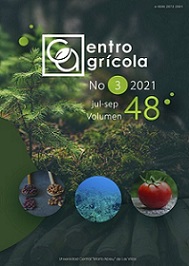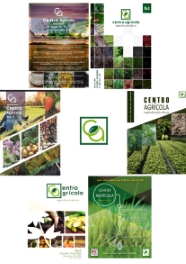CE:3217 CF: cag024172144
RESEARCH ARTICLE
In vitro colonial inhibition of an isolate from Colletotrichum acutatum Simmonds to fungicide treatments
Inhibición colonial in vitro de un aislado de Colletotrichum acutatum Simmonds a tratamientos con fungicidas
Dagoberto Guillén Sánchez1, Celeste Isamar Cadenas Vásquez1, Irán Alia Tejacal2, Víctor López Martínez2, María Andrade Rodríguez2 y Porfirio Juárez López2
1 Universidad Autónoma del Estado de Morelos, Escuela de Estudios Superiores de Xalostoc. Av. Nicolás Bravo s/n, Parque Industrial Cuautla, Xalostoc, Ciudad Ayala, Morelos, México, CP 62740
2 Universidad Autónoma del Estado de Morelos, Facultad de Ciencias Agropecuarias. Av. Universidad 1001, Colonia Chamilpa, Cuernavaca, Morelos, México, CP 62209
E-mail: This email address is being protected from spambots. You need JavaScript enabled to view it.; This email address is being protected from spambots. You need JavaScript enabled to view it.; This email address is being protected from spambots. You need JavaScript enabled to view it. This email address is being protected from spambots. You need JavaScript enabled to view it. This email address is being protected from spambots. You need JavaScript enabled to view it.
ABSTRACT
The aim of the research was to evaluate the in vitro sensitivity of Colletotrichum acutatum antracnosis to seven fungicides. It began with an isolate preserved in the ceparium of the Phytopathology Laboratory of the High School Studies of Xalostoc, Morelos. A completely randomized design was used to evaluate the fungicides benomyl, diphenoconazole, azoxystrobin, trifloxystrobin, copper oxychloride, fluoxastrobin and captan, at high, medium and low doses, for a total of 22 treatments with six repetitions. Sterile distilled water was applied to the control. The treatments were applied at a rate of 5 mL per plate, which contained PDA medium and a mycelial disc (Ø 5 mm). The inoculated plates were incubated at 24 °C, in 12 hour photoperiod. The colony diameter was measured every 24 hours and the percent inhibition was calculated. A bifactorial variance analysis was performed, according to Fungicide and Dose; and the differences between treatments were detected by the LSD test with 95 % confidence. The diameter of the colony and the percentage of inhibition did not show differences for dose levels, without significant effects for the interaction of both factors, fungicides, and dose. However, all doses of the different fungicides inhibited colony growth compared to the control. The benomyl, difenoconazol and captan fungicides were able to totally reduce the growth of the C. acutatum colony; followed by copper oxychloride, azoxystrobin, fluoxastrobin and trifloxystrobin in decreasing order. Only benomyl, difenoconazol, captan and copper oxychloride achieved more than 50 % inhibition.





